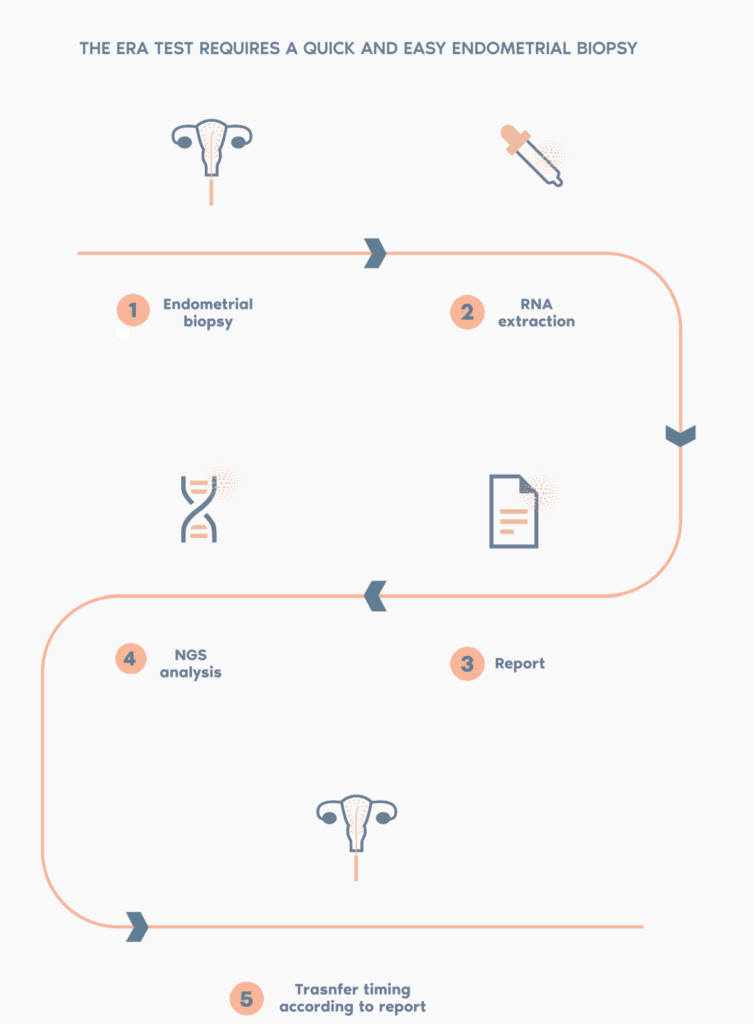Maximize your chances of pregnancy without losing good embryos
ERA® Endometrial Receptivity Analysis
Request informationERA® Endometrial Receptivity Analysis
Request information


If you’re interested in the ERA® test, talk to your doctor to see if it’s a good testing option for you, since it might not be indicated for every woman.
If your doctor recommends the test, he or she will order it for you. It must be ordered by a physician.
If you have been pregnant before you are more likely to receive a receptive result than other women who have never been pregnant before. However, if an embryo was transferred outside the ideal window of implantation, the chance of pregnan- cy is reduced, though not to zero. If you’ve been pregnant before, you can still receive a non-receptive result. The ERA® test can therefore still be valuable and pinpoint the time in which the chance of pregnancy is the highest, especially if you’ve had multi- ple unsuccessful embryo transfers.
When carrying out the same exact medical protocol (same medications, type of cycle, hours of progesterone, administration type, dosage, etc.) and with proper control of endogenous progesterone (endogenous progesterone level measured within the 24 hours prior to the first intake of exogenous progesterone and <1ng/ml), the ERA® results can be applied in a personalized embryo transfer (pET) for up to 2 years following the ERA® biopsy.
Reproducibility of the results may be affected by a change in endometrial thickness (should remain within similar range: 12mm), dramatic weight gain or loss (+/-20kg (44lbs)), and surgical intervention to the uterus (such as amyomectomy).
Therefore, if you have experienced any of these alterations since your previous ERA®, you may consider repeating the test.
A recommendation regarding the timing of embryo transfer can be made in approximately 90% of the cases. For the remaining of cases a recommendation to repeat the test would be made. Your ERA® test report will indicate if embryo transfer or repeat testing is recommended.
You might need to repeat your ERA® test if you get an inconclusive result. This happens in less than 5% of cases.
Having a receptive result after ERA® testing can be really reassuring and it can feel good to cross something off of the list of potential explanations for infertility. On the other hand, learning that the best time for you to transfer embryos is different of what is typical can provide you with an explanation for why you weren’t getting pregnant before and, more importantly, can give you a renewed sense of hope for when you’re ready to try again.
Having an abnormal result at ERA® testing should not be scary or discouraging, since it doesn’t require medication, surgery or any additional treatment. You’d only need the timing for embryo transfer to be adjusted to match your body’s timing.
There is a good prognosis of pregnancy after a personalized embryo transfer.
In order to have an ERA® test performed you must undergo an endometrial biopsy.
The endometrial biopsy is performed at your fertility center, so the risks are best discussed with your physician, who will be performing the procedure. The endometrial biopsy is a common procedure that is performed for other reproductive tests in addition to ERA®.
A receptive result does
not guarantee a pregnancy as there are other reasons why the pregnancy may not occur after embryo transfer.
The ERA® test does not tell us about other existing endometrial pathologies, the health or quality of an embryo, nor about the likelihood of a pregnancy to carry all the way to term.